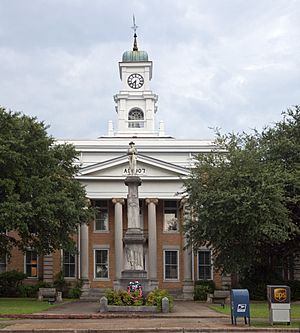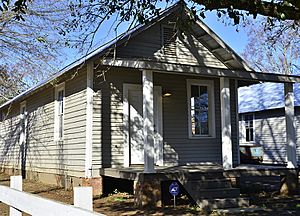Hale County, Alabama facts for kids
Quick facts for kids
Hale County
|
||
|---|---|---|

Hale County Courthouse and Confederate statue in Greensboro
|
||
|
||

Location within the U.S. state of Alabama
|
||
 Alabama's location within the U.S. |
||
| Country | ||
| State | ||
| Founded | January 30, 1867 | |
| Named for | Stephen F. Hale | |
| Seat | Greensboro | |
| Largest city | Moundville | |
| Area | ||
| • Total | 657 sq mi (1,700 km2) | |
| • Land | 644 sq mi (1,670 km2) | |
| • Water | 13 sq mi (30 km2) 1.9% | |
| Population
(2020)
|
||
| • Total | 14,785 | |
| • Estimate
(2023)
|
14,888 |
|
| • Density | 22.504/sq mi (8.689/km2) | |
| Time zone | UTC−6 (Central) | |
| • Summer (DST) | UTC−5 (CDT) | |
| Congressional district | 7th | |
|
||
Hale County is a county located in the west central portion of the U.S. state of Alabama. As of the 2020 census, the population was 14,785. Its county seat is Greensboro. It is named in honor of Confederate officer Stephen Fowler Hale.
Hale County is part of the Tuscaloosa, AL Metropolitan Statistical Area.
Contents
History

Hale County was established following the end of the American Civil War, on January 30, 1867. Located in the west-central section of the state, it was created from portions of Greene, Marengo, Perry, and Tuscaloosa counties. The vast majority of the territory came from Greene County. The first American settlers in this area had been southerners migrating from Georgia, Tennessee, Kentucky, and the Carolinas.
Hale County is connected to three major twentieth-century artists: Walker Evans photographed the area in 1936 while he collaborated with James Agee on the 1941 book Let Us Now Praise Famous Men. Since the 1960s, artist William Christenberry, born in Tuscaloosa, has been photographing various structures in Hale County as part of his multi-media artistic investigations. More recently, Hale County has become the home of the nationally recognized Auburn University Rural Studio, an architectural outreach program founded by architect and artist Samuel Mockbee and D. K. Ruth. It is also the birthplace of Eugene Sawyer, the second African American mayor of Chicago. In 2019 the film Hale County This Morning, This Evening by artist RaMell Ross was nominated for an Academy Award for Best Documentary Feature, poetically addressing the region's shift in demographics and the power of intra-community authorship.
Since the American Civil War, whites have controlled much of the economic and political power in Hale County, enforced early by violence and later by the decades of disenfranchisement of black voters and statewide imposition of Jim Crow. In the first half of the 20th century, many African Americans left the county in two waves of migration to cities and northern and western industrial centers. Beginning in the late 1960s, they recovered the ability to vote.
In 1997, after a highly contested mayoral election, the city of Greensboro elected its first black mayor, John E. Owens Jr. Claude Hamilton, the first African-American chief of police, was appointed in 2000. In 2006, black and white county residents joined in electing the first black county sheriff, Kenneth W. Ellis, who was formerly the Moundville police chief.
Hale County has suffered economic decline, particularly in the southern more rural end of the county. Many manufacturing plants closed during late 20th century restructuring, and population and businesses declined with the loss of jobs, especially in and around Greensboro (the county seat). The northern portion of the county, however, has enjoyed population and industrial growth due to its proximity to Tuscaloosa County. The latter has been a growing center of industry and new businesses, anchored by the University of Alabama and its large student body and resources.
Geography
According to the United States Census Bureau, the county has a total area of 657 square miles (1,700 km2), of which 644 square miles (1,670 km2) is land and 13 square miles (34 km2) (1.9%) is water.
Adjacent counties
- Tuscaloosa County (north)
- Bibb County (northeast)
- Perry County (southeast)
- Marengo County (south)
- Greene County (west)
National protected area
- Talladega National Forest (part)
Demographics
| Historical population | |||
|---|---|---|---|
| Census | Pop. | %± | |
| 1870 | 21,792 | — | |
| 1880 | 26,553 | 21.8% | |
| 1890 | 27,501 | 3.6% | |
| 1900 | 31,011 | 12.8% | |
| 1910 | 27,883 | −10.1% | |
| 1920 | 24,289 | −12.9% | |
| 1930 | 26,265 | 8.1% | |
| 1940 | 25,533 | −2.8% | |
| 1950 | 20,832 | −18.4% | |
| 1960 | 19,537 | −6.2% | |
| 1970 | 15,888 | −18.7% | |
| 1980 | 15,604 | −1.8% | |
| 1990 | 15,498 | −0.7% | |
| 2000 | 17,185 | 10.9% | |
| 2010 | 15,760 | −8.3% | |
| 2020 | 14,785 | −6.2% | |
| 2022 (est.) | 14,888 | −5.5% | |
| U.S. Decennial Census 1790–1960 1900–1990 1990–2000 2010–2020 |
|||
2020 Census
| Race / Ethnicity (NH = Non-Hispanic) | Pop 2000 | Pop 2010 | Pop 2020 | % 2000 | % 2010 | % 2020 |
|---|---|---|---|---|---|---|
| White alone (NH) | 6,803 | 6,213 | 5,792 | 39.59% | 39.42% | 40.39% |
| Black or African American alone (NH) | 10,074 | 9,265 | 8,313 | 58.62% | 58.79% | 56.23% |
| Native American or Alaska Native alone (NH) | 30 | 23 | 34 | 0.17% | 0.15% | 0.23% |
| Asian alone (NH) | 25 | 35 | 18 | 0.15% | 0.22% | 0.12% |
| Pacific Islander alone (NH) | 4 | 1 | 5 | 0.02% | 0.01% | 0.03% |
| Other race alone (NH) | 11 | 7 | 23 | 0.06% | 0.04% | 0.16% |
| Mixed race or Multiracial (NH) | 81 | 76 | 271 | 0.47% | 0.48% | 1.83% |
| Hispanic or Latino (any race) | 157 | 140 | 149 | 0.91% | 0.89% | 1.01% |
| Total | 17,185 | 15,760 | 14,785 | 100.00% | 100.00% | 100.00% |
As of the 2020 United States census, there were 14,785 people, 5,650 households, and 3,611 families residing in the county.
2010 census
As of the 2010 United States census, there were 15,760 people living in the county. 59.0% were Black or African American, 39.8% White, 0.2% Asian, 0.2% Native American, 0.3% of some other race and 0.6% of two or more races. 0.9% were Hispanic or Latino (of any race).
Transportation
Major highways
Airports
- Greensboro Municipal Airport (7A0) in Greensboro
- Moundville Airport (L44) in Moundville
Tourism
Greensboro, the county seat, is home to the Safe House Black History Museum. On March 21, 1968, Martin Luther King Jr. attended a meeting at Greensboro's St. Matthew Church, and then spent the night in this house where he sought refuge from the Ku Klux Klan. The museum reveals the struggle for equality for African Americans in Alabama, and its founder, Theresa Burroughs, was both a family friend of King, and a foot soldier in the Civil Rights Movement. Historically William Burns Paterson had set up Tullibody Academy for African Americans in Greensboro.
Greensboro is also home to a large number of antebellum-era houses and churches, including some that are listed on the National Register of Historic Places such as Glencairn and Magnolia Grove.
Education
All residents in the county are in the Hale County School District.
Communities
City
- Greensboro (county seat)
Towns
- Akron
- Moundville (partly in Tuscaloosa County)
- Newbern
Unincorporated communities
Ghost towns
Notable people
- William Christenberry (1936–2016), artist and photographer, born in Hale County
See also
 In Spanish: Condado de Hale (Alabama) para niños
In Spanish: Condado de Hale (Alabama) para niños

